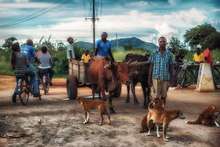Katete
Katete is a medium town in the Eastern Province of Zambia, and is headquarters of Katete District. The town is at the foot of rocky hills which lie to its east, including Mpangwe Hill and Kangarema Hill, which rise to 1600 m and are surrounded by cultivated fields. It lies on the Great East Road about 90 km south-west of the provincial capital, Chipata at an elevation of 1060 m on the watershed between the middle Luangwa River and the Zambezi. In the town is a major road junction, with a surfaced road branching off and running 50 km to the Mozambique border and connecting with Tete on the Zambezi 339 km to the south-east.

History
Although Katete now lies on the Great East Road, in the 1950s Katete was a small settlement down a dirt track. At the road junction there was a just filling station and a handful of shops run by Indian traders. The settlement was to service an "NRG" (Northern Rhodesia Government) secondary technical school for African male students. The school had a brickyard where mud bricks were handmade and kiln-fired. Subjects included woodwork, agriculture, sugar-making (from sugar cane), and leather tanning, but academic subjects such as arithmetic and science were also taught. The teachers, who were mainly European, lived in bungalows in the settlement.
The school was known as the Area School and part of the Eastern Province, NRG Development Area. The school dealt specifically with adult education which also included mass literacy in the Chichewa vocabulary that included women. This latter was based on the Frank Laubach system and refined by Hope Hay whose husband Rev Arthur Hay built and was first principle of the school.
Katete was a bus stop on the Great East road for the Thatcher Hobson Servivce which was where the small commercial centre was sited. (to correct the modern impression of a 'filling station', in those days fuel came in 44 gallon drums with a siphon tube)The NRG administrative and educational settlement was South of this point while St Francis Church mission hospital and an agricultural research station lay to the North. The area was also known for several tobacco farms cultivated by white settlers.
References
- Terracarta/International Travel Maps, Vancouver Canada: "Zambia, 2nd edition", 2000